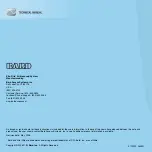
4.14.5 Chorus
A chorus or flanger effect is obtained by summing a
signal with a delayed copy of itself. When the delay
is continuously varied with a low-frequency oscillator
and separately for the left and right channel, the sound
becomes thicker and more spatial. Using smaller delay
times and adding feedback results in a flanging effect.
Mode
•
Single
simulates a standard chorus effect with
one delay line for each channel.
•
Dual
uses two delay lines per channel, to obtain
a yet thicker sound.
Offset
Adjusts the minimum delay time. Medium to high set-
tings are useful to create a typical chorus affect, while
low values are useful for flanging.
Rate
Sets the modulation rate of the effect in Hertz (Hz).
Depth
Sets the modulation depth of the LFO. Set to zero,
there is no modulation and thus no sweeping effect,
the sound will be static.
LR Offset
Since the chorus operates in stereo, both channels
have their own LFO. With the offset knob, the rel-
ative phase difference between both channels can be
adjusted from 0 to 180 degrees. Set to zero, both chan-
nels produce an identical sweep, while nonzero values
make the chorus effect more spatial.
Feedbk
The output of the chorus delay lines can be fed back to
their input, creating a resonance effect. Both positive
and negative feedback is possible, at center position
there is no feedback. For a classic chorus sound, the
feedback should be set to zero. For flanging effects,
use strong positive or negative feedback.
Dry/Wet
Mixes the dry and processed signal. Since the chorus
effect is achieved by mixing the original with a delayed
copy of itself, the mix ratio should be typically around
50
DUNE 2 User’s Manual
Summary of Contents for DUNE 2
Page 1: ...User s Manual...
















































